The secret of the Master Class
Why was Bobby Fischer so good? What is Carlsen's recipe to dominate the chess world? Why was Capablanca so incredibly hard to beat? How could Kasparov calculate so precisely?
Our selection of top players from the last 200 years has enchanted the chess world. Of course, the same question keeps coming up: Why were these players so good?
Our chess experts Dorian Rogozenco, Dr. Karsten Müller, Mihail Marin, Oliver Reeh, Niclas Huschenbeth, Yannick Pelletier and Jonas Lampert have worked long and hard to give you an understanding of the chess secrets of the best players in history.

The complete bundle offers you:
- More than three days of video material (approx. 78 hours)
- Interactive tactics tests with video feedback
- Background knowledge, short biographies, statistics and tables on all twelve Grandmasters
- The opening repertoire of the players with a variation tree in Powerbook form
- Tactics training with thousands of games, including questions for training
- And of course a wealth of games from all players, with in-depth analysis and commentary from our experts
Learn from the best players in the world! The "MasterClass" series introduces you to the facets of the chess legends. In interactive video format with training feedback! Only this week: Volume 1 to 12 with Fischer, Carlsen, Kasparov, Karpov and many more
Original DVD with signature of Anand and Kramnik!
Speaking of the best players in the world, we have something else for you! Whoever buys the Master Class Bundle this week (until Sunday, August 16, 2020 / 23:59 CEST) automatically gets the chance to win one of three DVD's of the "World Championship Chess" series by Viswanathan Anand or Vladimir Kramnik, with their original signatures! These DVD's have a high collector's value and are a great prize for every chess fan!
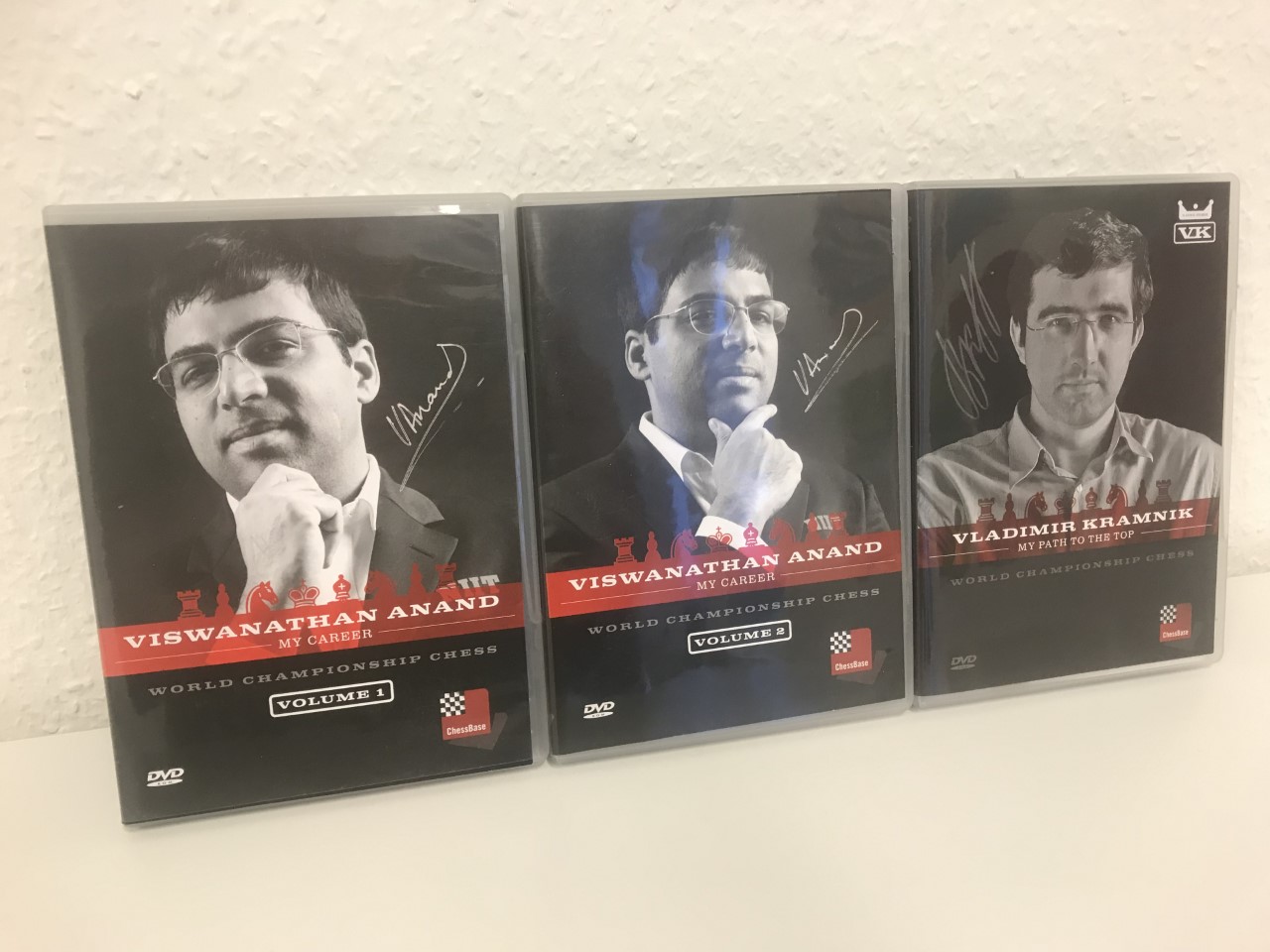
Vol. 01 - Bobby Fischer
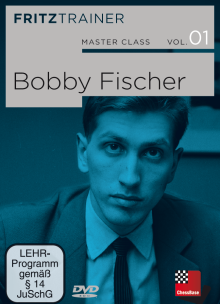
No other World Champion was more infamous both inside and outside the chess world than Robert James Fischer. But what were the secrets to his sensational ability, and what enabled him to take on the Soviet school of chess alone – and win? On this DVD, a team of experts presents you every facet of the chess legend, and shows you the winning techniques and strategies employed by the 11th World Champion. Grandmaster Dorian Rogozenco delves into Fischer’s openings, and retraces the development of his repertoire. What variations did Fischer play, and what sources did he use to arm himself against the best Soviet players? Mihail Marin explains Fischer’s particular style and his special strategic talent in annotated games against Spassky, Taimanov and other greats. Karsten Müller is not just a leading international endgame expert, but also a true Fischer connoisseur. His congenial video analysis of Fischer’s legendary endgames can only be found on this DVD! To top it off - you too can unleash tactical combinations like Fischer! German Bundesliga player Oliver Reeh has compiled the World Champion’s best combinations – and now it’s your move. You too can try to find Fischer’s stunning brilliancies by entering your solution on the board and receive video feedback in the new ChessBase media format!
Vol. 02 - Mihail Tal
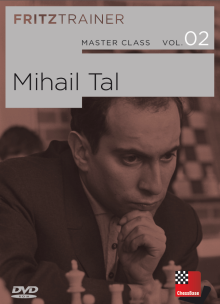
No World Champion has enchanted the chess world as much as Mihail Tal did. His reign as World Champion was short but in his time Tal’s star burned with unknown intensity. With his combinations and his intuitive sacrifices the young Tal ran over his opponents, and thrilled the chess world with his risky uncompromising attacking play, which inspired many players to emulate him. In 1960 he beat the reigning World Champion Botvinnik but one year later he lost the title of World Champion again in a return match of doubtful competitive value. But even though Tal was no longer World Champion, he still remained one of the best players in the world. At eight chess Olympiads he won gold with the Soviet team. Six times he became USSR-Champion. In 1973/74 he managed to remain unbeaten in 93 consecutive games, a still unmatched record. In 1988 he won the Blitz World Championship. Despite his frail health Tal enjoyed life to the fullest and was a funny and brilliant man, who loved nothing more than chess. Through the games of Mihail Tal this DVD provides a unique access to the realm of chess tactics. Tal’s colleagues dubbed their tactical guru „Magician“, because in his games seemingly incomprehensible moves in the end blended into a successful whole, as if by magic. But Tal was also a master of strategy and endgame play. On this DVD Dorian Rogozenco, Mihail Marin, Oliver Reeh and Karsten Müller present the 8. World Chess Champion in video lessons: his openings, his understanding of chess strategy, his artful endgame play, and finally his immortal combinations. In an interactive test they invite you to try to find combinations like Tal did. The DVD also contains all games by Tal, many of them annotated, plus comments and tournament tables.
Vol. 03 - Alexander Aljechin
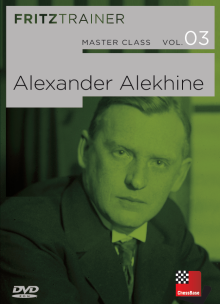
Alexander Alekhine, the fourth World Champion, played many fantastic attacking games and to this day enjoys the reputation of being an attacking genius. But ever since Alekhine won the World Championship match against Capablanca in Buenos Aires 1927 the chess world could see that the Russian-born Alekhine – who immigrated to France in 1921 – also handled technical positions excellently. But his success against Capablanca was still a surprise because the Cuban was considered to be virtually unbeatable. After winning the World Championship Alekhine reached the peak of his career in the early 1930s winning famous tournaments such as San Remo 1930 and Bled 1931 by a huge margin. Moreover, the World Champion was also a prolific author and in annotating his games gave deep insights to the thinking of a World Champion. Alekhine was one of the best players in the history of chess and treated all phases of the game – opening, middlegame and endgame – in textbook fashion. No wonder a lot of later top class players, not least Garry Kasparov, claimed Alekhine as their role model in chess. On this DVD Grandmasters Dorian Rogozenco, Mihail Marin, Karsten Müller, and International Oliver Reeh present outstanding games, stunning combinations and exemplary endgames by Alexander Alekhine. And they invite you to improve your chess knowledge with the help of video lectures, annotated games and interactive tests. The DVD also contains all known games by Alekhine, most of them annotated. Tables of important tournaments and various articles with background information complete the DVD.
Vol. 04 - José Raúl Capablanca

He was a child prodigy and he is surrounded by legends. In his best times he was considered to be unbeatable and by many he was reckoned to be the greatest chess talent of all time: Jose Raul Capablanca, born 1888 in Havana. At the age of 13 he became Cuban champion; in 1909 he sensationally defeated Marshall by 8:1 and was thus catapulted into the world elite. It was only after some time, since only sparse amounts of information made it across the pond, that in 1911 Capablanca achieved well-deserved recognition by leaving the elite of world chess trailing in his wake in San Sebastian. It would however take another 10 years before the Cuban defeated the reigning world champion Emanuel Lasker in their match and wore the crown himself.
On this ChessBase-DVD a team of experts gets to the bottom of Capablanca’s game. Niklas Huschenbeth presents the openings of the third world champion. Oliver Reeh has assembled a select choice of little combinations (Capablanca’s famous “petite combinaison”) and prepared them in interactive format. Mihail Marin looks into Capablanca’s strategic performances and finds astonishing parallels in the games of Bobby Fischer. Our end game expert Karsten Müller had a multiplicity of examples from which to choose, since Capablanca liked to liquidate into an endgame, being well aware of his particular strength and creating numerous masterpieces of the art of the endgame. The DVD also contains all of Capablanca’s games, many of them annotated and is rounded off by a biographical section, tables and both a tactics and an endgame database.
Vol. 05 - Emanuel Lasker

The name Emanuel Lasker will always be linked with his incredible 27 years reign on the throne of world chess. In 1894, at the age of 25, he had already won the world title from Wilhelm Steinitz and his record number of years on the throne did not end till 1921 when Lasker had to accept the superiority of Jose Raul Capablanca. But not only had the only German world champion so far seen off all challengers for many years, he had also won the greatest tournaments of his age, sometimes with an enormous lead. The fascinating question is, how did he manage that? Previously the answer frequently given was – psychology and luck. But this thesis has been refuted by authors who have to be taken seriously. Lasker’s secrets are obviously to be sought elsewhere.
On the ChessBase DVD a team of experts delves deeply into Lasker’s play. In more than 6 hours of video (both in English and in German) the authors cast light on four important aspects of Lasker’s artistry. Niclas Huschenbeth has looked into Lasker’s openings. Our tactics expert Oliver Reeh challenges you in our interactive format: can you too find Lasker’s brilliant moves? Mihail Marin describes the second world champion as an original strategic player who took his decisions based on the specific features of the position. For Karsten Müller, Lasker was a great pragmatist and a superb defensive player, which is reflected in the selection of endgames he has chosen to discuss.
Vol. 06 - Anatoly Karpov
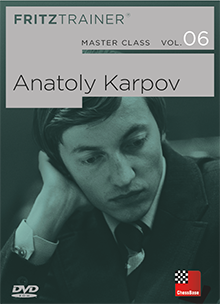
When Anatoly Karpov was 11 years old, he was invited to Botvinnik’s chess school. But the “Patriarch” passed a harsh verdict: “The boy has no clue about chess and therefore absolutely no future as a chess player.” Rarely was a judgement about a chess talent more wrong, for Karpov soon became the best player in the Soviet Union, growing to be considered a serious challenger to the reigning World Champion, Bobby Fischer. But in the World Championship match in 1975, Fischer refused to play and Karpov won by default, becoming the 12th World Champion. He nevertheless proved himself worthy of his title, playing in countless tournaments with exceptional results. Particularly impressive was his style. Thanks to Karpov’s brilliant feel for positional chess, which reminded many experts of Capablanca, he outplayed his opponents again and again with seemingly effortless ease. If you want to improve your grasp of chess strategy, then there is hardly a better teacher than Anatoly Karpov! It took the arrival of Garry Kasparov for Karpov to have an opponent who could challenge him on an equal footing.
On this DVD, a team of experts looks closely at the secrets of Karpov’s games. In more than 7 hours of video, the authors examine four essential aspects of Karpov’s superb play. Niclas Huschenbeth takes a look at Karpov’s openings. Our tactics expert Oliver Reeh tests your skills with interactive exercises, challenging you to find Karpov’s brilliant moves. Mihail Marin sees in Karpov’s play great similarities to Magnus Carlsen: by the time the opponent understands what is happening, it is already too late. For endgame expert Dr. Karsten Müller, Anatoly Karpov is “a living legend”. For him, Karpov has “an incredible feeling for the coordination and harmony of his pieces”, something which also shows in his endgames.
Vol. 07 - Garry Kasparov
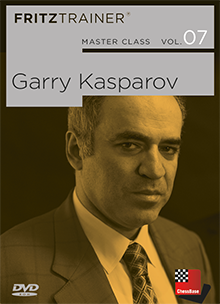
Garry Kasparov’s talent was recognised at an early age, but it was at the latest at the age of only 15 when he qualified for the renowned USSR national championship that he was also considered by the chess world as a whole as a possible future champion. But on the way to the throne of world champion Kasparov had to overcome numerous obstacles. Kasparov felt that he was being held back by the Karpov-friendly Soviet federation and by FIDE. He finally broke through and at the age of 22 became the youngest ever world champion. He also conducted his struggle at the board above all and enriched chess with his incredibly dynamic playing style as well as his scientific preparation for games. Kasparov was far ahead of his time in his employment of the new electronic aids: computers and database programs such as ChessBase. His numerous encounters with the pragmatic Karpov saw the collision of two quite different playing styles, styles in which these two players were far and away the best in the world. In addition to these matches, Kasparov also contested many tournaments and always appeared with the same mind-set: win games and tournaments!
On this DVD a team of experts gets to the bottom of Kasparov’s play. In over 8 hours of video running time (8 hours both in English and German) the authors Dorian Rogozenko, Mihail Marin, Oliver Reeh and Karsten Müller cast light on four important aspects of Kasparov’s play: the opening, strategy, tactics and the endgame. As a bonus there is video analysis of Kasparov’s computer games (Karsten Müller). In the major database with training questions (162 games with 575 training questions) you can hone your own tactical understanding with the help of Kasparov’s strokes of genius.
Vol. 08 - Magnus Carlsen
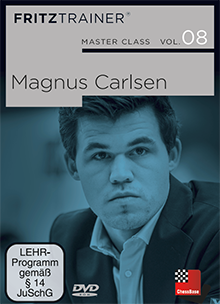
Scarcely any world champion has managed to captivate both chess lovers and the general public to the extent Magnus Carlsen has. The enormously talented Norwegian arrived on the scene as if from nowhere, without having been systematically trained within the structures of a major chess-playing nation such as Russia, the Ukraine or more recently, China. Rather, his development had taken place in an almost totally private setting. Upon recognizing his son’s unbelievable talent, his father took him out of school, bought a camper van and, together with the whole family, set about traveling from tournament to tournament. The rough diamond from Norway was gradually polished in countless tournament games, and was soon receiving invitations to top tournaments, where he proved his incredibly deep understanding of chess against even the world’s top players. Thanks to Carlsen’s style, computersupported opening preparation has faded somewhat into the background, with a greater importance being placed on the sporting side of chess – deep strategy, extensive endgame knowledge, energy and endurance are the trump cards of the new chess megastar. By 2010, Carlsen was already number one in the world ranking list; in 2013 he also claimed the title of World Champion, a title he has now successfully defended twice.
On this DVD, experts including Mihail Marin, Karsten Müller, Oliver Reeh and Niclas Huschenbeth examine the games of the 16th World Champion. Let them show you how Carlsen tailored his openings to be able to outplay his opponents strategically in the middlegame or to obtain an enduring advantage into the endgame, and bear witness to how the Norwegian always managed to find a way to pose his opponents serious problems, even in apparently level endings.
Vol. 09 - Paul Morphy

Learn about one of the greatest geniuses in the history of chess! Paul Morphy’s career (1837-1884) lasted only a few years and yet he managed to defeat the best chess players of his time. After his triumphal journey to Europe in the years1858/1859 the American was hailed as the unofficial world champion. But how was it possible for Morphy to outplay his experienced opponents with such ease? What were his particular strengths?
Our team of experts gets to the bottom of the “Morphy myth” and in about 5 hours of video running time they cast light on the most important facets of his ability. One focal point in this is Oliver Reeh’s “Tactics column”: you are invited in 20 interactive training videos to look into Morphy’s legendary combinatory skill over the board. But don’t worry, the International Master from Hamburg helps you find the solutions with tips and video feedback on your moves and ideas! In addition Jonas Lampert describes for you Morphy’s opening repertoire and explains the concepts which underpin the course of the game. Grandmaster Mihail Marin has examined the American’s strategic play and comes to a surprising conclusion: in no way does his positional understanding lag behind his tactical ability! And last but not least endgame expert Karsten Müller works out the strengths and weaknesses in Morphy’s endgame technique. On the DVD you will find all the games of the genius from New Orleans as well as a detailed biography by Thomas Eichhorn.
Vol. 10 - Mikhail Botvinnik
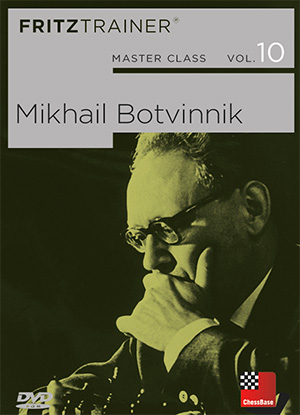
Learn from a World Champion!
Mikhail Botvinnik became world champion in 1948 and remained so until 1963. During this time he either successfully defended his title against David Bronstein, Vassily Smyslov and Mihail Tal or got it back in a return match. The systematic, scientific method of working in chess begins with Botvinnik. He studied openings with respect to their typical middlegame structures and for those he developed successful strategies. The strategic approach runs like a red thread through Botvinnik’s work. Towards the end of his active career, the 6th world chess champion, known in the Soviet Union as the “patriarch”, founded a chess school and passed on his knowledge to numerous bright students. Amongst his students were, for example, Garry Kasparov and Vladimir Kramnik.
On this DVD grandmasters and experts such as Yannick Pelletier, Mihail Marin, Oliver Reeh and Karsten Müller show, using the games of Mihail Botvinnik, how to employ specific openings successfully, which model strategies are present in specific structures, also how to find tactical solutions and solid rules for how to bring endings to a successful conclusion. Anyone who would like to win his or her games in a positional manner and where possible without tactical risks will find in the games of Mikhail Botvinnik valuable guidelines. Many of his games belonged in the days of the “Soviet School of Chess” to the basic education of young players in strategy and endgame play and even today are still of incalculable value as guides to the successful conduct of a game.
Vol. 11 - Vladimir Kramnik
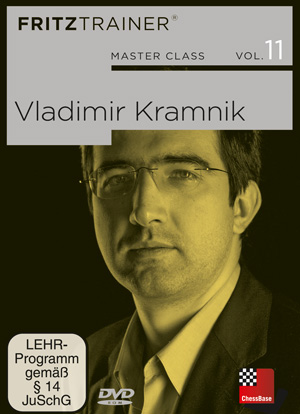
For Garry Kasparov it had been clear for quite some time who would be his successor as world chess champion: none other than Vladimir Kramnik! In 1992 Kasparov brought the 17-year old into the Russian team and the latter justified his early inclusion with eight wins and one draw in the Chess Olympiad in Manila. Eight years later Kramnik in fact defeated his mentor in the world championship match in London and became the 14th chess world champion. It was thanks to Kramnik that the split between world championships which had begun in 1993 was brought to an end. Kramnik defended his title in 2004 against Peter Leko and in the reunification match in 2006 he defeated Veselin Topalov. In 2007 Kramnik lost the title to Viswanathan Anand at the world championship tournament in Mexico and was also defeated by the Indian in 2008 in the return match. Even after losing the title of world champion Vladimir Kramnik has continued to remain among the absolute elite of players in the world – till the present day. With his deep understanding of chess Vladimir Kramnik is considered one of the greatest masters of strategy in the history of the game. His flawless technique has enabled him to bring to a successful conclusion innumerable encounters in the endgame. In the realm of opening theory too Kramnik is one of the leading players. In addition to many other contributions, he has decisively shaped the theory of the Berlin Defence to the Ruy Lopez and that of the Catalan Opening with many original ideas. This DVD allows you to learn from the example of one of the best players in the history of chess and from the explanations of the authors (Yannick Pelletier, Mihail Marin, Karsten Müller and Oliver Reeh) how to successfully organise your games strategically, consequently how to keep your opponent permanently under pressure and how to bring your games to a successful conclusion with accurate technical endgame play. Through Vladimir Kramnik’s games it is possible, moreover, to follow the history and development of numerous popular openings and thus obtain a better understanding of the ideas behind them.
Vol. 12 - Viswanathan Anand

When Viswanathan Anand appeared on the European chess stage, he had already achieved a number of successes in India, such as winning the Indian Junior Championships and the National Indian Championship while still being a junior. Anand was only 14 years old when he was invited to play for the Indian National team at the Chess Olympiad 1984. In 1987 he became World Junior Champion and in 1988 the 19-year-old became India’s first grandmaster.
After the reunification of the PCA and the FIDE in 2006 Anand won the World Championship Tournament 2007. In 2008 he successfully defended his title in a World Championship match against Vladimir Kramnik to become the only World Champion who won or defended the title in three different formats: in a knock-out tournament, in a round robin, and in a match. In 2010 (against Topalov) and 2012 (against Gelfand) Anand successfully defended his title but in 2013 he lost his World Championship match against Magnus Carlsen and though Anand won the Candidates Tournament 2014 he lost the World Championship rematch 2014 against Carlsen. Anand is still one of the world’s top players and has caused a real chess boom in his home country India where Anand is a national hero. Countless young Indians strive to follow Anand’s example and want to succeed in the international chess arena.
Anand’s style is marked by a deep understanding chess but also by quickly grasping tactical patterns and opportunities. As a junior he stunned his opponents with the great speed of his play. He sometimes only used ten or fifteen minutes of his thinking time, and it is no surprise that he later was the world’s best blitz and rapid player for decades.
This DVD allows you to learn from the example of one of the best players in the history of chess and from the explanations of the authors (Yannick Pelletier, Mihail Marin, Karsten Müller and Oliver Reeh) how to successfully organise your games strategically, consequently how to keep your opponent permanently under pressure and how to bring your games to a successful conclusion with accurate technical endgame play. Through Viswanathan Anand’s games it is possible, moreover, to follow the history and development of numerous popular openings and thus obtain a better understanding of the ideas behind them.
Learn from the best players in the world! The "MasterClass" series introduces you to the facets of the chess legends. In interactive video format with training feedback! Only this week: Volume 1 to 12 with Fischer, Carlsen, Kasparov, Karpov and many more
Links:
All Master Class DVD's in our ChessBase Shop
.jpeg)




































